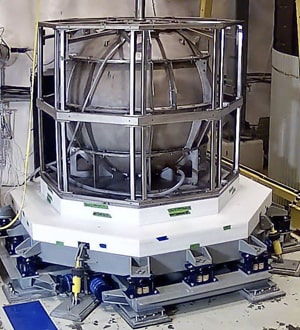Introduction
At the University of Alberta, researchers are working to develop ultra-sensitive devices to improve dark matter detector technologies. This requires high-precision measurements, initially as a prototype in the lab and ultimately as an online monitoring system to be installed at 2km underground. Moku:Lab’s compact form factor and versatility enable researchers to perform experiments in a variety of environments to determine the sensitivity of detectors to dark matter.
The challenge
Dark matter is estimated to account for over 80% of the mass in our universe, but remains one of the biggest mysteries in physics. While its existence has been inferred by its gravitational effect on ordinary matter, scientists are hard at work developing detector technologies in hopes of observing dark matter particles. In collaboration with the NEWS-G (New Experiments with Spheres – Gas) experiment, Dr. Marie-Cecile Piro, Assistant Professor of Physics at University of Alberta, and her group are working with detectors called spherical proportional counters, which contain neon and methane gas.

Figure 1: The NEWS-G experiment’s dark matter detector during installation at SNOLAB, 2km underground (image from NEWS-G collaboration).
The probability of dark matter interacting with the detector is directly related to the amount of methane in the detector. “The amount of methane impacts the sensitivity of the detector – even a 1% difference would be huge – so we need very high-precision measurements,” said Dr. Piro. “We are currently developing with my M.Sc. student, Carter Garrah, a laser spectroscopy technique for ppb-level detection of methane to be able to extract our sensitivity to dark matter when analyzing the physics data.”
While initial development and characterization of the prototype measurement system will be done in the Piro lab, ultimately it will be deployed with the main detector which is located 2km underground to shield experiments from cosmic rays. Live, ongoing monitoring of methane concentrations in the detector will be essential to ensure the active target properties of the detector over time.
The solution
Researchers at the University of Alberta selected Moku:Lab based on its combination of measurement performance, flexibility, and compact design. Moku:Lab’s Lock-in Amplifier allows them to detect very small signals to accurately measure methane levels in the detector. The built-in oscilloscope provides visualization of the signal at different points in the signal processing chain to troubleshoot or optimize the experiment. “This is really helpful during commissioning, for example, to understand any issues and determine what settings you need,” said Dr. Piro.

Figure 2: Block diagram of the prototype laser spectroscopy measurement system. The gas from the detector circulates through the LAS tube and where laser spectroscopy is used to detect the methane concentration. Moku:Lab detects the photodiode output signal and generates an error signal to drive the diode laser (image from Carter Garrah).
Moku:Lab’s compact form-factor makes it easy to work with in the lab and ensures they will be able to deploy it to monitor the main detector when the system is ready. Using the iPad wireless display allows them to move around the lab while controlling the measurements. Access to the additional integrated instruments will also prove useful as they explore other aspects of this and related projects.

Figure 3: Laser spectroscopy measurement system prototype physical setup shown in the lab (image from Carter Garrah).
The result
In the search for dark matter, many mysteries remain. With so many unknowns, equipping a lab can be difficult, but Dr. Piro and team are looking forward to exploring the possibilities with Moku:Lab. “Having Moku:Lab will be an asset for analyzing the signals and monitoring gas concentration, but I’m sure we will find other applications as well,” she said. Moku:Lab’s high-precision Lock-in Amplifier is an essential piece of equipment to determine the NEWS-G detector’s sensitivity to dark matter as they endeavor to understand more about the universe.
Have questions or want a printable version?
Please contact us at support@liquidinstruments.com








